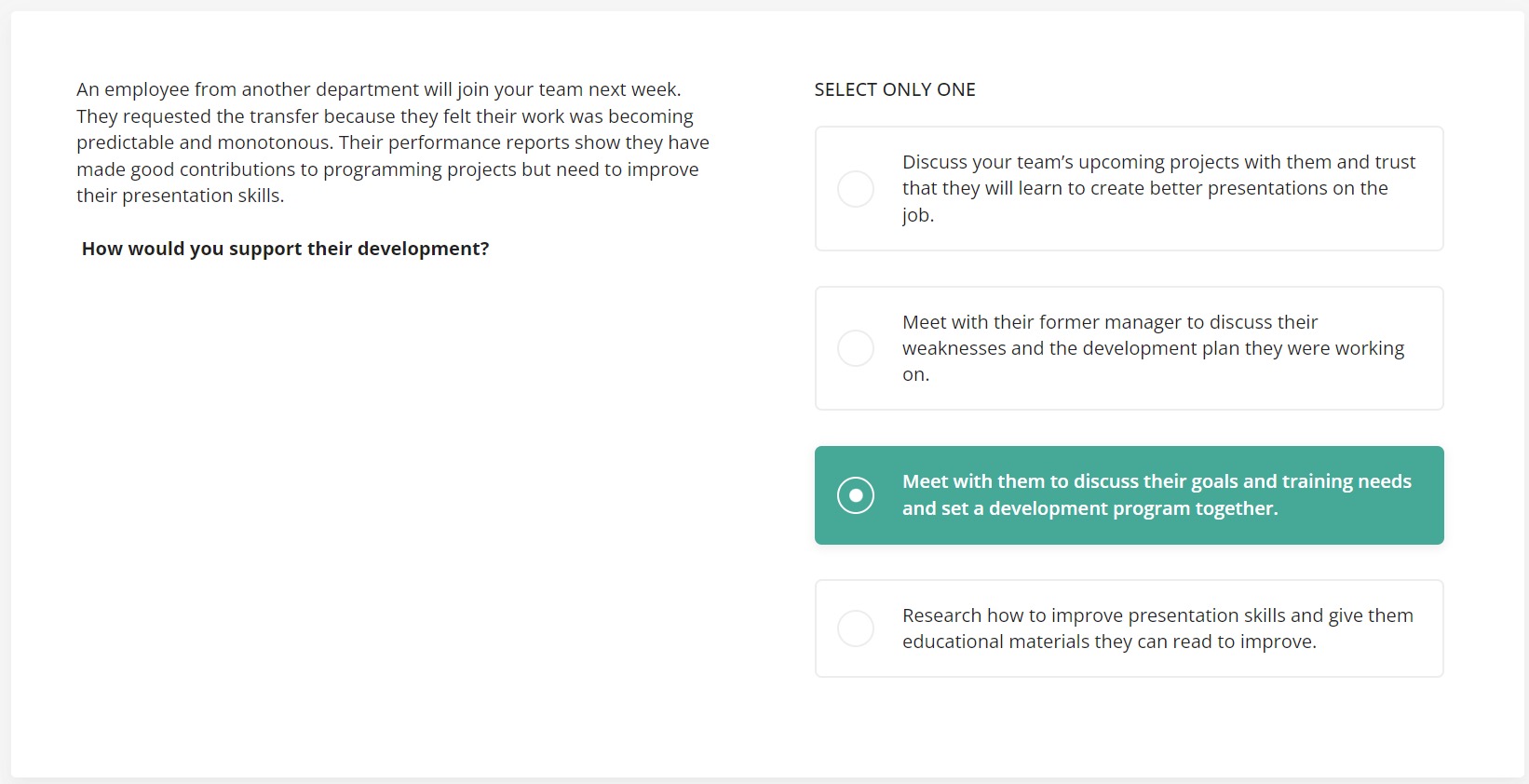Culture change in the workplace is the process of shifting your organization’s actions to better align with new values, such as increasing fair hiring efforts to support diversity and inclusion.
Changing organizational culture is often necessary to transform the work environment for the better. It inspires employees, enhances their performance, and increases productivity.
This article discusses how a positive company culture transformation is a powerful way to improve an organization by reviewing seven inspirational culture change examples.
Table of contents
- What is organizational culture?
- Why is company culture important?
- The reasons and benefits of organizational culture change
- 7 inspiring organizational culture change examples in the workplace
- How can TestGorilla help you promote positive culture change?
- Be intentional about changing organizational culture and see amazing results
- Organizational culture change FAQs
What is organizational culture?
Organizational culture is a set of values, customs, norms, and general beliefs that guide and inform the experience employees have working for a company. It includes their objectives and achievements, the leadership they must follow, and the values they must uphold to align with the company’s mission.
A good company culture is essential for business success because it provides consistency, direction, and guidance, fueling people to develop their potential.
Why is company culture important?
Assessing organizational culture is vital for companies. Culture fuels your goals and purpose, and it's one of the highest priorities for workers:
56% of employees say company culture is more important to them than salary when it comes to job satisfaction
79% of adults consider a company’s mission and purpose before applying there
Changing the culture of a workplace is a process of modifying a company’s goals, values, practices, and processes to alter its work environment. It is increasingly popular today as positive workspaces, employee experience, and wellbeing are critical modern trends.
Further, changing corporate culture affects profit and revenue. A company with a healthy culture is 1.5 times more likely to enjoy a 15% revenue increase in three years.
The reasons and benefits of organizational culture change
Examples of cultural change happen for many reasons, but they all ultimately impact the company’s growth.
Here are the top reasons why company culture transformation benefits your business:
Benefit | Description |
Better employee morale | Reducing workplace negativity increases employee engagement, motivation, and loyalty. It also facilitates better conflict resolution. |
Increased productivity | Providing a new work environment that is more rewarding and nurturing as early as onboarding can help improve productivity among all staff members. |
Less stress | Employees feel more comfortable carrying out their tasks when a company forgives mistakes and enables them to set boundaries. It also reduces the pressures on management. |
Better business reputation | A positive work environment helps you establish a strong business reputation that increases interest in job vacancies and builds fruitful professional relationships. |
7 inspiring organizational culture change examples in the workplace
Organizational culture change examples are essential when transforming your organization’s culture. Reviewing organizations that have succeeded in building a strong culture helps inspire solid ideas and drum up motivation.
Here are seven great company culture change examples and the impact they had.
1. Aetna
Aetna, a managed healthcare company, is one of the most powerful organizational culture change examples that affects productivity and satisfaction.
In the early 2000s, Aetna had many issues:
Rapport with customers had deteriorated
Reputation damaged by lawsuits and public backlash
Losing $1m per day
The company’s poor culture caused these problems. It encouraged an inflexible environment that was resistant to change, and after merging with the U.S. Healthcare, it couldn’t adapt, and the situation worsened.
It continued until John W. Rowe, the new chief executive, identified the problem. Rather than force a cultural shift in a company that was resistant to change, Rowe engaged with employees and involved them in planning.
He identified Aetna’s problem: The company had focused on managing material expenses while alienating patients, which harmed its strengths, including its concern for its customers.
That realization began a positive cultural change for Aetna, which turned it into an efficient growth engine.
Key takeaway: Never lose sight of your strongest purpose, and work with your staff to identify important issues.
2. Squarespace
Squarespace, a website-building and hosting SaaS company, has a powerful mission to help people with creative ideas succeed, and its company culture focuses on encouraging team members to express their creativity.
In its early days, this company encouraged a culture of hard work and trust – the idea that you work on what you can but rely on others to support you.
An intentional approach to culture helped this company ensure its staff’s happiness throughout rapid organizational growth:
Date | Number of employees |
2010 | 30 employees |
2015 | 550 employees |
2018 | 1,200 employees |
2022 | 1,800 employees |
The ratings employees give the company reflect this. According to Comparably, 94% of employees are happy to be working there.
Key takeaway: Be intentional about your positive current culture and promote an environment of trust.
3. Salesforce
Salesforce, the cloud software giant, is a strong organizational culture example. Its employer brand is about a positive environment that keeps evolving.
This company devoted itself to building a sense of community, stressing four core values that enable everyone to feel at home:
Trust
Customer success
Innovation
Equality
The last one is especially important to Salesforce as it aims to eliminate the wage gap and hire without bias.
The company is also famous for its community giveback concept, the 1-1-1 model. Giving back to the community has proven beneficial, as it supports team building, attracts outside support, and entices new employees to become devoted to the cause.
Key takeaway: Focus on your employees and community to build an organization that the public and future candidates support.
4. Zappos
Zappos, an online shoe and clothes retailer, is one of the top examples of change in the workplace. It even offers a three-day culture camp to teach HR personnel how to build a similar culture.
It wasn’t always this way. This company began with a strict hierarchical structure where budget and resources were allocated from the top, making teams focus on internal problems rather than customer needs.
Zappos realized it needed a change, so it adopted 10 core values that ensure every team contributes to the company and is satisfied with the experience there. These values include:
Openness to learning
Adaptability
Positivity
This company also compensates new employees for quitting if they don’t feel the job is right for them, making it a positive experience to sustain a culture-aligned team.
Examples of organizational culture change like Zappos prove that investing in customer service, company culture, and employee development is beneficial and powerful.
Key takeaway: Using change management to make positive changes internally improves customer relations and has other perks, like inspiring other companies.
5. IBM
IBM specializes in innovation. However, this focus isn’t limited to its products but also extends to its openness to culture change in the workplace.
This company has developed a strong culture by creating an innovative employee feedback system.
IBM used to rely exclusively on annual performance reviews, which didn’t account for:
Employees changing roles
Employees developing in their current roles
Employees rapidly reaching their goals
It also prevented real-time learning opportunities for managers and new hires.
This company realized it needed new processes. It adopted “Checkpoint,” a system that facilitates open communication and feedback between all people, regardless of their organizational rank.
It no longer uses a strict 1-10 rating scale, letting deeper, more personalized insights into each member’s experience encourage improvements and create a more people-oriented environment.
Key takeaway: Shift your practices to suit your people, and you can improve fast.
6. Southwest Airlines
Southwest Airlines is one of the best company culture change examples done right.
This company started in the 1960s and managed to compete against older, bigger, and more established airlines mostly because of its top-tier company culture.
The core of Southwest’s culture is that its employees, rather than its customers, come first. Southwest defends this by arguing that happy employees ultimately result in high customer satisfaction and increased earnings.
It’s an unusual method to approach customer service, especially in a customer-centered industry like air travel, but it works – Southwest Airlines has an impeccable reputation for high customer satisfaction.
While establishing these cultural values, Southwest aims to promote leadership across all company levels. These initiatives have made Southwest a desirable workplace and an admirable organizational culture example.
Key takeaway: Take care of your employees, and they take care of your customers.
7. HubSpot
Changing a culture in the workplace is difficult, but HubSpot approaches it just as it would a product. It views its culture as an item to review and optimize, frequently refining and improving it.
To make this even more approachable, HubSpot created a 128-slide presentation called the Culture Code.
The Culture Code contains the company’s values, decision-making processes, and performance management. HubSpot also focuses on employee development by providing free classes, books, TED talks, and other development programs to upskill talent.
HubSpot has many distinct values, but the following line inspires future examples of cultural change: “Whether you like it or not, you’re going to have a culture. Why not make it one you love?”
Key takeaway: Review and improve your culture like it’s a product to see meaningful differences.
For more inspiration and examples of change in the workplace, check out our guide to building a positive workplace culture.
How can TestGorilla help you promote positive culture change?
Cultural change examples are inspirational, but what action can you take now that you’re motivated?
Skills-based hiring has a striking effect on your company, encouraging a positive environment, healthier relationships, and happier employees. It happens by gauging new candidates with talent assessments to discover their true skills and capabilities.
For example, using our Leadership & People Management test to hire strong leaders ensures they have the skills to do their jobs confidently, and their team has a competent, empathetic leader.
Interested in seeing more questions? Check out our leadership sample questions.
Our Culture Add test is another great test for building a strong culture, ensuring candidates align with your culture without excluding people like traditional culture fit practices do.
Excellent organizational culture change examples have come from using skills-based hiring. TruTrip transformed its hiring process with TestGorilla talent assessments, eliminating bias, enhancing candidate quality, and improving teamwork, collaboration, and communication.
Changing the culture of a workplace is a gradual process, and skills-based practices help make it sustainable, noticeable, and simple. They align workers to the new culture and keep all stakeholders abreast of this work culture and its milestones.
Be intentional about changing organizational culture and see amazing results
These cultural change examples show that intentional, people-centric ideas lead to outstanding success. Your employees are the heart of your company, so it’s vital to value and support them. It’s also important to ensure you’re hiring the right employees for your desired culture.
Organizational culture change examples display what happens when a culturally aligned team gets together and creates a positive environment, and you can build that kind of team with talent assessments.
You can explore talent assessments in-depth in our product tour, where we detail a skills-based hiring process and how it works.
If you’re looking for a more guided approach, book a demo to speak to one of our experts.
Build a strong, diverse team with TestGorilla
Start forming a strong, diverse team that shares your company’s purpose with TestGorilla's talent assessments.
Organizational culture change FAQs
To finish up, let’s answer a few frequently asked questions about changing the culture in the workplace.
What are cultural changes in an organization?
Cultural changes in an organization are gradual, consistent processes that improve your work environment. These changes usually achieve a specific goal, such as increased customer satisfaction or improved employee feedback. Organizational culture change examples include implementing a new staff review system or encouraging adaptability.
Can an organization change its culture?
Yes, organizational culture change is definitely possible. Change initiatives are a positive and healthy way for companies willing to improve and adapt their entrenched habits and ways of working. However, it’s a gradual process of small, sustainable efforts rather than grand gestures. Scroll back up to the heading titled “7 inspiring organizational culture change examples in the workplace" to read stories of companies that have done it.
What are the characteristics of positive organizational culture?
The elements of a positive organizational culture are within a company’s values, goals, and practices. These elements include transparency, accountability, trust, respect, and diversity. Companies can achieve these characteristics through wellness promotion, clear expectations, employee development, and a feedback culture. You can also build a positive culture through skills-based hiring practices. Creating an unbiased recruitment process helps you hire a culturally aligned candidate without focusing on irrelevant personal information.
What companies changed their culture?
Some cultural changes examples include Zappos, Aetna, and IBM. These organizations saw a pressing need in the form of dissatisfaction and turnover and took action to achieve employee buy-in and better retention, establishing a safe environment, healthy feedback, and development opportunities.
How can you successfully manage cultural change in an organization?
Adopt new technology to ease the change
Assess your current organizational culture
Ensure your culture aligns with your organizational strategy and goals
Learn from other company culture change examples
Practice transparent communication throughout the process
How has organizational culture changed over the years?
Modern ideas have changed corporate culture, including greater respect for diversity, autonomy, and wellbeing. Increasingly, companies prioritize their employees’ personal lives, wellness, and workload capacity, which means that many of them are working to shift their culture to a healthier, more people-centric environment to keep up with modern needs.
Related posts
Hire the best candidates with TestGorilla
Create pre-employment assessments in minutes to screen candidates, save time, and hire the best talent.
Latest posts
The best advice in pre-employment testing, in your inbox.
No spam. Unsubscribe at any time.

Hire the best. No bias. No stress.
Our screening tests identify the best candidates and make your hiring decisions faster, easier, and bias-free.
Free resources
This checklist covers key features you should look for when choosing a skills testing platform
This resource will help you develop an onboarding checklist for new hires.
How to assess your candidates' attention to detail.
Learn how to get human resources certified through HRCI or SHRM.
Learn how you can improve the level of talent at your company.
Learn how CapitalT reduced hiring bias with online skills assessments.
Learn how to make the resume process more efficient and more effective.
Improve your hiring strategy with these 7 critical recruitment metrics.
Learn how Sukhi decreased time spent reviewing resumes by 83%!
Hire more efficiently with these hacks that 99% of recruiters aren't using.
Make a business case for diversity and inclusion initiatives with this data.






















